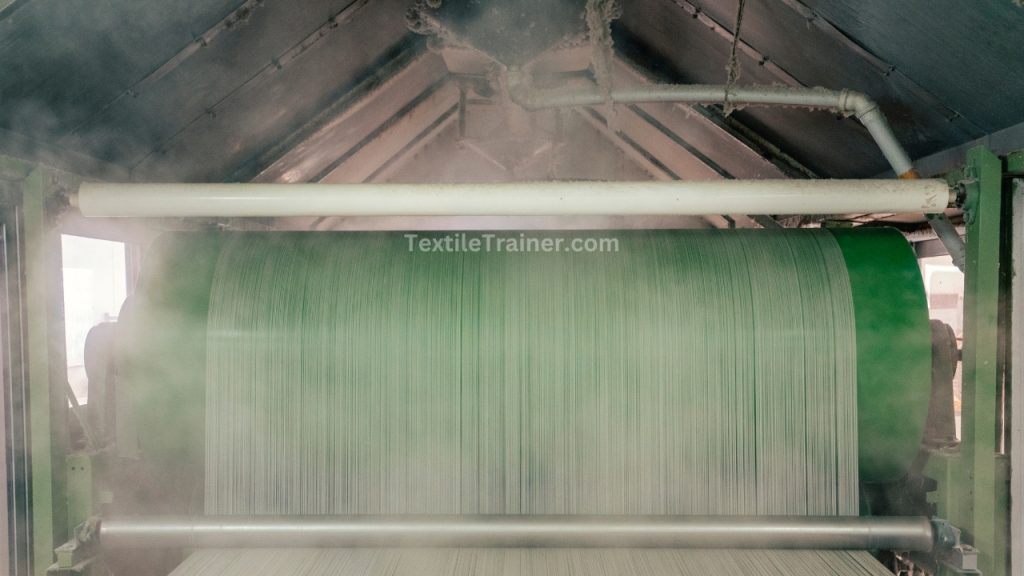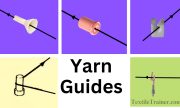What is Sizing?
A process that entails applying an adhesive coating to the yarns surface is called sizing. This is regarded as the most important operation for the weaving process, particularly with blended and filament yarns, where it ensures maximum weaving efficiency. Sizing in weaving section is important step that impact the next weaving process.
In other word, On the loom, warp yarn undergoes substantial friction and stretching efforts during the weaving process. Thus, the yarn becomes mossy, and single fibers are detached from it, leading to breakages. To decrease breakages, a special treatment is applied to the warp to make it stronger. this treatment is called sizing and consists in coating the warp yarn with a thin film which takes up the friction and protects the yarn from becoming mossy.

Objectives of Sizing in Weaving section:
- Sizing reduces the hairiness, weakness of warp thread.
- Sizing is used to remove electrolytic formation for synthetic or blended yarn.
- In weaving, warp yarns are the vertically aligned threads, which are protected by sizing. As these threads pass through the loom during weaving, they are subjected to friction and tension. Through sizing, warp yarns are protected from excessive breakage and damage during weaving.
- The use of sizing increases the strength and reduces the tangling of the warp yarns, improving their weave ability and allowing for better weaving.
- During weaving, sizing minimizes the chances of abrasion and wear on the weave by reducing the friction.
- Size plays an important role in the overall quality of a woven fabric as it ensures uniformity in the fabric structure, resulting in a smoother surface and better aesthetics.
- Sizing helps to economize the use of raw materials, as it reduces yarn breakage and minimizes waste during the weaving process.
Impact of Sizing in Weaving on Warp Yarn:
In warp yarns, the size is one of the most important factors affecting the performance and characteristics of the fabric. This article explores some of the effects of warp yarn sizing as follows:
- Breaking Strength: sizing increased the breaking strength of warp yarn. During weaving, sizing increases the resistance of warp yarns to breakage by acting as a protective layer around them. As a result of the increased strength, the fabric is less likely to snap due to excessive tension and friction.
- Abrasion Resistance: Sizing increases the abrasion resistance of warp yarns by reducing friction, resulting in a fabric that is more resistant.
- Stiffness: Warp yarns get stiffer when they are sized. Due to the presence of sizing agents, sizing can make the warp yarns stiffer. It may be necessary to balance the stiffness during weaving to ensure consistent spacing and alignment of yarns, but in the final product it should be balanced to maintain drape and softness.
- Elasticity: While the protective layer can provide some elasticity, it is generally less than that of un-sized warp yarns.
- Frictional Resistance: The sizing reduces friction between warp yarns, enabling them to move more smoothly during weaving and maintaining the integrity of the warp threads.
- Yarn Diameter: Using sizing agents can increase the yarn diameter slightly, which may require adjustments in loom settings and fabric design to accommodate the increased diameter.
- Extension: When warp yarns are sized, the extension or elongation properties can be affected. extension of warp yarn is decreased when size is apply.
- Electrostatic Charge: The presence of sizing agents may reduce the generation of static electricity during weaving, which can be beneficial in preventing issues like yarn tangling and dust accumulation.
- Hairiness: Sizing can reduce yarn hairiness, resulting in cleaner shed openings and less defecting yarns. Lower hairiness results in cleaner shed openings during weaving.
- Costing: As a result, sizing increases the strength of the warp yarn, which in turn makes the warp yarn breakage rate less. As a result, sizing helps to reduce the costing of warp yarn. In this context, we can say that sizing saves the cost of warp yarn by increasing its strength.
Overall, warp yarn sizing in weaving is a critical step in weaving that has an impact on numerous fabric properties. Weavers can achieve fabrics with greater strength, abrasion resistance, and dimensional stability while maintaining the desired drape, softness, and appearance by optimizing sizing agents and techniques.
References:
- Adanur, S. (2001). Handbook of weaving. Boca Raton: CRC press.
- banerjee, N. (2000). Weaving Mechanism. West Bengal: Smt. Tandra Banerjee and Sri Apurba Banerjee.
- Belal, P. D. (2016). Understanding Textiles for a Merchandiser. Dhaka: LB Graphics & Printing.
- Hossain, M. S. (2014). Introduction to Textile Engineering. Dhaka: Books Fair Publications.
- Rahman, M. M. (2008). Fabric Manufacturing Technology. Dhaka: Books Fair Publications.
- V. Gordeev, P. V. (1982). Cotton Weaving. Russia: Mir Publishers Moscow.







I’m impressed by the quality of this content! The author has obviously put a huge amount of effort into researching and arranging the information. It’s exciting to come across an article that not only provides valuable information but also keeps the readers engaged from start to finish. Kudos to him for creating such a remarkable piece!
thank you
I?ve been exploring for a little bit for any high-quality articles or weblog posts on this sort of space . Exploring in Yahoo I eventually stumbled upon this website. Reading this info So i am glad to show that I’ve an incredibly good uncanny feeling I found out just what I needed. I such a lot undoubtedly will make certain to do not omit this site and give it a glance on a relentless basis.
thank you….
My brother recommended I might like this blog. He used to be totally right. This submit truly made my day. You can not consider just how so much time I had spent for this information! Thank you!
thank you….please stay with us.
What?s Happening i am new to this, I stumbled upon this I have found It positively helpful and it has helped me out loads. I hope to contribute & assist other users like its helped me. Great job.
thanks you..
Hello there! This is my first comment here so I just wanted to give a quick shout out and say I genuinely enjoy reading through your blog posts. Can you suggest any other blogs/websites/forums that cover the same subjects? Thanks a ton!
sorry, I can’t…
I loved as much as you will receive carried out right here. The sketch is attractive, your authored material stylish. nonetheless, you command get bought an impatience over that you wish be delivering the following. unwell unquestionably come more formerly again as exactly the same nearly a lot often inside case you shield this hike.
thank you….
Admiring the time and energy you put into your blog and detailed information you provide. It’s good to come across a blog every once in a while that isn’t the same old rehashed information. Fantastic read! I’ve saved your site and I’m adding your RSS feeds to my Google account.
thank you…
Hello there, I found your site via Google while searching for a related topic, your site came up, it looks good. I have bookmarked it in my google bookmarks.
Thank you dear…. Stay connected.
There’s noticeably a bundle to find out about this. I assume you made certain nice factors in features also.
thanks for comment..
I loved as much as you will receive carried out right here. The sketch is attractive, your authored subject matter stylish. nonetheless, you command get got an shakiness over that you wish be delivering the following. unwell unquestionably come more formerly again as exactly the same nearly very often inside case you shield this hike.
I used to be suggested this website through my cousin. I’m no longer certain whether this publish is written by way of him as no one else recognize such particular about my problem. You are amazing! Thank you!
Thanks too.stay connected
Generally I don’t learn post on blogs, but I wish to say that this write-up very forced me to try and do it! Your writing taste has been amazed me. Thanks, quite great post.
I like what you guys are up also. Such clever work and reporting! Carry on the excellent works guys I have incorporated you guys to my blogroll. I think it will improve the value of my website 🙂
Thanks for your post. One other thing is that individual states have their own laws which affect house owners, which makes it very difficult for the our lawmakers to come up with a new set of recommendations concerning home foreclosure on home owners. The problem is that every state has got own regulations which may work in a damaging manner with regards to foreclosure policies.
Thanks. Stay connected
We’re glad you found our post helpful
Thank you for taking the time to address my concerns in your reply on the blog. I truly appreciate it.
very good post, i actually love this web site, carry on it
I was recommended this website by way of my cousin. I’m no longer positive whether or not this put up is written by means of him as nobody else recognize such detailed approximately my trouble. You are amazing! Thank you!
Welcome
Hi there! I know this is kinda off topic but I was wondering if you knew where I could get a captcha plugin for my comment form? I’m using the same blog platform as yours and I’m having problems finding one? Thanks a lot!
Welcome. Plz stay connected
After exploring a number of the blog posts on your site, I really appreciate your technique of blogging. I bookmarked it to my bookmark website list and will be checking back in the near future. Please check out my website as well and tell me what you think.